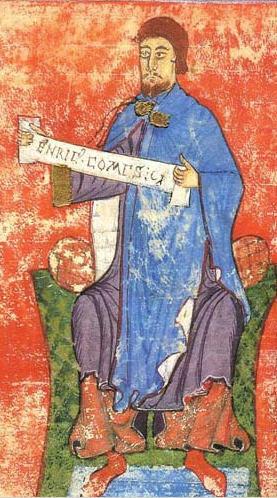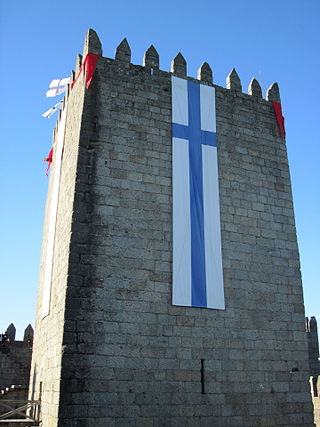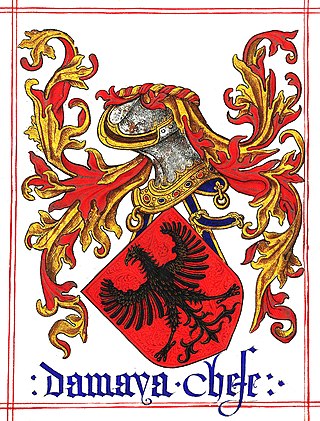Related Research Articles

Afonso I, also called Afonso Henriques, nicknamed the Conqueror and the Founder by the Portuguese, was the first king of Portugal. He achieved the independence of the County of Portugal, establishing a new kingdom and doubling its area with the Reconquista, an objective that he pursued until his death.

Afonso II, nicknamed the Fat or the Leper, was the third king of Portugal and the second but eldest surviving son of Sancho I of Portugal and Dulce of Aragon. Afonso succeeded his father on 27 March 1211.

Theresa was Countess of Portugal, and for a time claimant to be its independent Queen. She rebelled against her half-sister Queen Urraca of León. She was recognised as Queen by Pope Paschal II in 1116, but was captured and forced to accept Portugal's vassalage to León in 1121, being allowed to keep her royal title. Her political alliance and amorous liaison with Galician nobleman Fernando Pérez de Traba led to her being ousted by her son, Afonso Henriques, who with the support of the Portuguese nobility and clergy, defeated her at the Battle of São Mamede in 1128.

Henry, Count of Portugal, was the first member of the Capetian House of Burgundy to rule Portugal and the father of the country's first king, Afonso Henriques.

The Battle of São Mamede took place on 24 June 1128 near Guimarães and is considered the seminal event for the foundation of the Kingdom of Portugal and the battle that ensured Portugal's independence. Portuguese forces led by Afonso Henriques defeated forces led by his mother Teresa of Portugal and her lover Fernão Peres de Trava. Following São Mamede, the future king styled himself "Prince of Portugal". He would be called "King of Portugal" starting in 1139 and was recognised as such by neighbouring kingdoms in 1143.
This is a historical timeline of Portugal.
Madragana Bat Aloandro, later Maior or Mór Afonso, was a woman from the Algarve known as a mistress to king Afonso III of Portugal, in the 13th century, when he ended the Reconquista in Portugal by taking Faro in 1249. Faro was at that time the last part of the Kingdom of the Algarve still in Muslim hands, and there her father was the Qadi.

Boticas is a municipality in northern Portugal. The population in 2011 was 5,750, in an area of 321.96 km2.

Gonçalo Mendes da Maia, also known as O Lidador, so named for his fearlessness in the struggle against the Saracens, was a Portuguese knight of the time of Afonso Henriques, about whom tradition relates important achievements in the events preceding the independence of Portugal.

The Castle of Faria is a castle in the northern Portuguese civil parish of Gilmonde, municipality of Barcelos, in the Cávado.

The Maia family was an old and powerful Portuguese noble family with its origins dating back to the 10th century.

Egas Moniz de Riba Douro, also known as o Aio (1080-1146) was a Portuguese nobleman, who served in the Portuguese Crown as the tutor of Afonso Henriques.
Gil Vázquez de Soverosa was a member of the nobility of the Kingdom of Portugal, of the Soverosa lineage which had its origins in Galicia. He appears frequently as a member of the curia regis confirming royal charters of Kings Sancho I, Afonso II, and Afonso III of Portugal.
Mem Soares de Melo, 1st Lord de Melo was a Portuguese nobleman who served in the court of Afonso III of Portugal.
Raimundo Pais de Riba de Vizela (?–?) was a Portuguese nobleman, who served as tenente of Covilhã, Gouveia and Besteiros.
Paio Pires de Guimarães (1100–?) was a medieval Knight and Rico-homem of the County of Portugal. He was Lord of Riba de Vizela.
Martim da Maia (1350–1434) was a Portuguese nobleman, 1st Lord of Trofa in the Kingdom of Portugal.

João Afonso Telo, was the 4th Lord of Albuquerque and the 1st Count of Barcelos.

Monastery of Santo Tirso is a monastery located in the parish of Santo Tirso, municipality of Santo Tirso, in Portugal, that was of the Benedictine Order.

Urraca Henriques was an infanta of Portugal, daughter of Henrique de Borgonha, count of Portucale and Teresa de Leão, condessa of Portugal. She was the sister of Afonso Henriques, the first king of Portugal.
References
- ↑ Portugal em definição de fronteiras, 1096-1325: do condado portucalense à crise do século XIV, Volume 4. Editorial Presença, 1996. 1996. ISBN 9789722320399.
- ↑ Identificação de um país: ensaio sobre as origens de Portugal, 1096-1325, Volume 1. José Mattoso. 1995. ISBN 9789723310351.
- ↑ Grande enciclopédia portuguesa e brasileira: Ilustrada com eêrca de 15.000 gravuras e 400 estampas a côres, Volume 29. Editorial Enciclopédia. 1959.